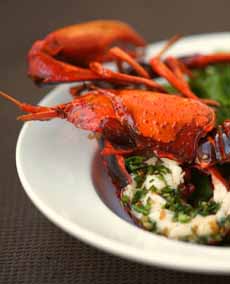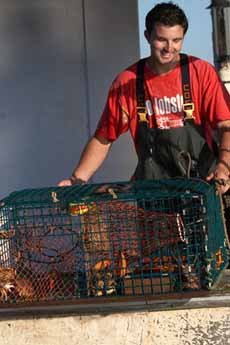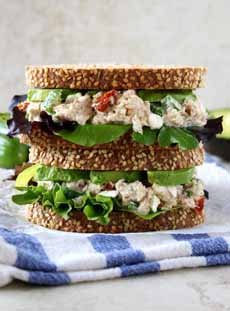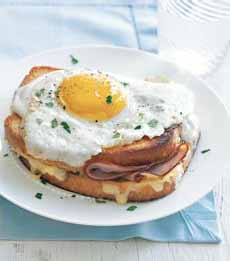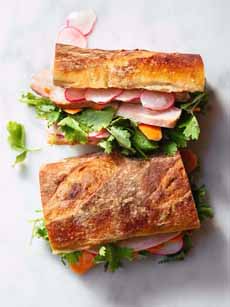|
If you love pasta but not the idea of a steaming plate of it on a hot summer day, the solution is simple: cold pasta.
Cold noodles have been a standard in Asia since…the creation of pasta? That was around 1700 B.C.E. in China (here’s the the history of pasta).
The recipes that follow were developed by the corporate chefs at Melissa’s, the largest distributor of specialty produce in the U.S. With more than 1000 items available at any given time, Melissa’s sells both domestic products and exotic fresh fruits and vegetables from around the world.
These are Asian flair, but western tomato sauces and olive oil-based sauces work as well on any cold pasta preparation you want to put together. A plate of angel hair with chilled vodka sauce or linguine with fresh (uncooked) tomato sauce—fresh basil on both—is just right on a hot day.
You can substitute conventional wheat pasta for the buckwheat (soba) and rice noodles, as well as gluten-free pasta made from legumes and other vegetables.
The chefs at Melissa’s are always whipping up something new. Even if you aren’t purchasing produce, take a look at them for inspiration.
There are four cold noodle recipes below:
Recipe #1: Shrimp Pancit
Recipe #2: Grilled Chicken & Soba Noodle Salad
Recipe #3: Thai Beef Summer Yakisoba Noodle Salad
Recipe #4: Grilled Shrimp & Soba Noodle Salad
THE DIFFERENCE BETWEEN PASTA & NOODLES
Pasta is Italian for “paste,” which refers to the paste of flour and water that is turned into ribbon noodles and short cuts (bowties, corkscrews, etc.).
Noodles, from the German word “nudel,” refer to paste made with an egg.
In the U.S., the term refers to egg noodles as well as Asian forms of pasta. Noodles can be made from wheat, rice, bean, potato, or other flour, like oat; from sweet potato or arrowroot starch; from bean curd skin and tofu; and from mung bean threads.
Italian pasta is always made from durum wheat flour.
See the different types of pasta and noodles in our Pasta Glossary.
First up is pancit, a Filipino dish. Pancit is the Filipino (Tagalog) word for noodles, derived from a Hokkien word for “convenient food.”
Noodles were introduced by immigrants from China or East Asia, and readily adopted into local cuisine, with each region creating its own combination of noodles and other ingredients (just as in Italy).
According to the food lore handed down by the Chinese, noodles should be eaten on one’s birthday for long life and good health. Chinese restaurants in the Philippines often have “birthday noodles” on their menus. These are long noodles: it wouldn’t do to serve short cuts when you seek a long life [source].
RECIPE #1: SHRIMP PANCIT
This recipe, from Melissa’s corporate chef Miki Hackney, has been taken down a notch in fat. “Pancit is usually pretty high in saturated fats,” says Chef Miki. “I have made a ‘lighter’ version by omitting the traditional frying of noodles in rendered chicken fat, then including the fried skin in the dish.”
Ingredients For 8 Servings
For The Dressing
1½ cup chicken stock
4 tablespoons soy sauce
5 tablespoons chopped garlic
2 tablespoons ginger, grated
1 tablespoons fish sauce
½ teaspoon sugar
¼ teaspoon chili flakes
Salt and pepper, to taste
For The Pancit
8 large shrimp, peeled and deveined (more as your budget permits)
½ teaspoon Old Bay seasoning
1 teaspoon peanut oil
1 chicken breast, boneless, skinless, and cut in half
1/2 teaspoon salt
Peanut oil, as needed
2 cups red onion, thinly sliced
1 1/2 cups Chinese long bean, cut into 1” pieces
2 cups carrot, julienne
8 ounces sliced button mushrooms
4 cups napa cabbage, ¼” sliced
2 baby bok choy, ¼” sliced
4 ounces snow peas, trimmed
Boiling water, as needed
14 ounces yakisoba noodles
8 ounces vermicelli rice noodles
Ice water bath
3 scallions, ¼” cut on bias
For The Garnish
1 cup cilantro leaves
3 calamondin or key limes cut into wedges
|
|

[1] Pancit, a Filipino specialty (photo courtesy Melissa’s).

[2] Mmm, shrimp (photo courtesy I Love Blue Sea).

[3] Grilled chicken with soba, buckwheat noodles (photo courtesy Melissa’s).
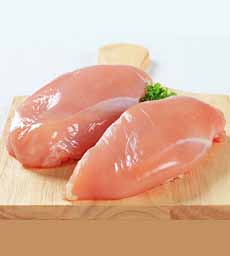
[4] Raw chicken breasts (photo courtesy Provisioner Online).

[5] Grated ginger photos courtesy (photo courtesy Luxury Thailand Travel).
|
Preparation
1. COMBINE the dressing ingredients in a small saucepan and heat to dissolve the sugar. Adjust the seasonings to taste. The dressing should have a slight tart taste. Set aside.
2. PLACE the chicken breast in a saucepan and cover by 1 inch with water. Add salt and bring to a boil; reduce to a simmer and cover. Simmer until the chicken is cooked through, about 20 minutes.
3. REMOVE the chicken from the liquid and place it on a plate to cool. When cool enough to handle, use two forks and pull apart the breast into rough shreds. Set aside and lightly cook the shrimp.
4. HEAT the yakisoba noodles by warming in a microwave or soaking in boiling water, loosening the bunches as they heat. Toss all the ingredients but the shrimp and plate. Garnish with the shrimp and cilantro, with the lime wedge on the side.
RECIPE #2: GRILLED CHICKEN & SOBA NOODLE SALAD
This and the remaining recipes are by Melissa’s corporate Chef Tom Fraker.
Ingredients For 6-8 Servings
For The Chicken
6-8 boneless, skinless chicken thighs
Garlic salt, to taste
Freshly ground pepper, to taste
Crushed red pepper to taste
Nonstick cooking spray
For The Dressing
4 tablespoons canola oil
1 tablespoon sesame oil
4 tablespoons seasoned rice Vinegar
1 lime, juiced
1 tablespoon ground ginger paste
Kosher salt and freshly ground pepper, to taste
Plus
3 bundles of buckwheat soba noodles
8 radishes or watermelon radishes, ends trimmed; cut into rounds
1/4 pound snow peas, strings removed; sliced on bias
1/4 pound broccoli florets
2 carrots, ends trimmed; cut into rounds
1/4 red cabbage, shredded
Preparation
1. PREPARE a hot grill. Season the chicken with the salt, pepper and red pepper. Spray the chicken with the cooking spray and place it on the grill.
2. COOK both sides until you reach an internal temperature of 165°F. Let the chicken rest for 5-6 minutes, then cut into bite-size pieces.
3. PREPARE the dressing: Place all of the ingredients in a mixing bowl and whisk to combine. Set aside.
4. PREPARE the noodles according to the package instructions, then rinse them with cold water and drain.
5. COMBINE all ingredients except the chicken in a bowl, add the dressing and toss. Place on a serving platter and top with the chicken.
|
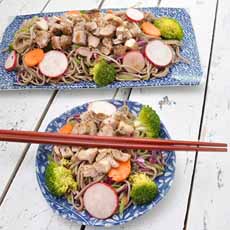
[6] Grilled chicken and soba noodles.
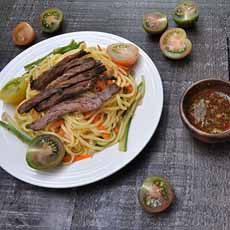
[7] Thai beef noodle salad.

[8] Yakisoba noodles (all photos courtesy Melissa’s). |
|
RECIPE #3: THAI BEEF SUMMER YAKISOBA NOODLE SALAD
Ingredients For 4-6 Servings
4 cloves garlic, peeled and sliced
½ sweet onion, diced
2 serrano chiles, cut into rounds
6 tablespoons hoisin sauce
1/2 cup soy sauce
2 tablespoons fish sauce
1 lime, juiced
3 tablespoons brown sugar
1 pound beef flap Meat
For The Dressing
1/4 cup lime juice
1 tablespoon chili garlic sauce
1 tablespoon brown sugar
2 tablespoons fresh cilantro, minced
1 tablespoon seasoned rice vinegar
3 packages Melissa’s Yakisoba stir Fry Noodles Original Flavor (or substitute)
3 mini cucumbers, ends trimmed; halved crosswise and julienned
2 carrots, ends trimmed; shredded
1 container baby heirloom tomatoes, halved
1 red Onion, diced small
Preparation
1. PLACE the marinade ingredients into a sealable plastic bag and add the meat. Massage the meat and place in the refrigerator. Marinate the meat for 2 hours or overnight, agitating it every so often.
2. PREPARE a hot grill and grill the steak to your desired doneness. Let it rest for 5-6 minutes, then slice.
3. COMBINE all of the dressing ingredients and set it aside.
4. PREPARE the noodles according to the package directions (without the flavor packet) and then rinse under cold water. Drain.
5. ASSEMBLE: Combine the steak, noodles, cucumbers, carrots, tomato and onion in a bowl. Add the dressing and mix well to combine.
|
RECIPE #4: GRILLED SHRIMP & SOBA NOODLE SALAD
Ingredients
12 large raw shrimp, peeled; deveined
Sea salt and freshly ground pepper, to taste
1 lime
1 red bell pepper, stem and seeds removed; quartered
1 green bell pepper, stem and seeds removed; quartered
1 yellow bell pepper, stem and seeds removed; quartered
1 sweet onion, peeled; sliced
Nonstick cooking spray, as needed
3 bundles of buckwheat soba noodles
1 Asian pear, cored; diced
10 leaves fresh basil, minced
Your favorite sesame-ginger salad dressing
Preparation
1. PREPARE a hot grill. Season the shrimp with the salt and pepper and place on the grill. Cook on both sides until the shrimp is opaque, about 2 minutes per side. Remove the shrimp and squeeze the juice from the lime over them. Set aside.
2. SPRAY the bell peppers and onion with the cooking spray and place on the grill. Cook until you get nice grill marks on both sides and then remove from the grill. Once cooled, slice the bell peppers and dice the onion.
3. PREPARE the soba noodles according to the package directions, then cool them under cold water. Drain.
4. ASSEMBLE: Combine the noodles, bell peppers, onions, pear and basil in a bowl. Place the salad on a serving platter, top with the shrimp and serve with the dressing. Makes about 4-6 servings.
CHECK OUT WHAT’S HAPPENING ON OUR HOME PAGE, THENIBBLE.COM.
|
|

